




What Are the Main Types of Habitats and Who Lives There?
We all live in homes, don't we? Just like us, animals and plants also have homes where they live. Have you ever wondered how a camel survives in a hot desert or the polar bear in the snow? Today, we are going to learn about habitats and which animals and plants live in which habitats. We will also know about the places and important facts related to such habitats. So, are you excited to learn about habitats?
Let’s Know About Habitats
A habitat is a natural home or environment where a plant or animal lives and grows. Our planet Earth has various kinds of habitats, such as hot deserts, rainforests, cold ice-covered lands, mountains, etc. Some plant or animal species are found in every habitat on Earth. It is important for us to protect these habitats because many living organisms depend on them for survival. These habitats help us study and understand the features of the animals and plants that live here and the factors that affect their survival.
Types of Habitats for Kids
Broadly speaking, there are two basic types of habitats. These include land habitats and water habitats. Land habitats comprise rainforests, deserts, and mountains among others. Freshwater and saltwater are the two main classifications of water habitats. Freshwater habitats include streams, rivers, swamps, marshes, ponds, and lakes. Saltwater habitats include oceans, seas, salt lakes, salt marshes, and saltwater swamps.
Let’s discuss the 5 major types of habitats.
1. Forest Habitat
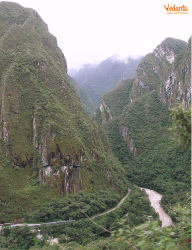
The Amazon Rainforest
When talking about forests, the most common one is the rainforests. This habitat is marked by high temperatures and a wet climate. Rainforest forests receive ample rainfall and sunlight and hence are home to a wide variety of plants and animals. Some rainforest trees can grow up to 200 feet.
Places: Rainforests can be found in Africa, Asia, Australia, and Central and South America. The Amazon rainforest in Brazil is the biggest rainforest in the world.
Plants and animals: Orchids, bamboo, rosewood, teak, and bromeliads are some of the common rainforest trees. Bengal tigers, chimpanzees, varieties of ants, anacondas, vampire bats, orangutans, tree frogs, and macaws are a few among the hundreds of animals found in rainforests.
2. Polar Habitat
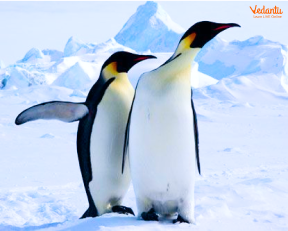
Penguins in the Polar Habitats
The North Pole and the South Pole are the major polar habitats. These comprise land that is completely covered in thick layers of ice. It can be as thick as three miles in some places. The polar habitat also experiences a group of continually shifting ice sheets and houses large icebergs. The temperatures at the poles are extremely cold. In the Arctic, minus 22°F is the average winter temperature. At the South Pole, the lowest temperature recorded was minus 129°F in Antarctica. During summer, the Sun shines all day long for 24 hours but it is not warm enough. However, in winter, it is dark throughout the day.
Places: Antarctica (South Pole) and parts of Canada and Greenland are near the North Pole.
Plants and animals: There aren’t trees in the polar habitat, but some types of small shrubs, lichens, mosses, and algae are there. Some of the popular animals include emperor penguins, walruses, narwhals, polar bears, arctic foxes, harp seals, etc.
3. Desert Habitat
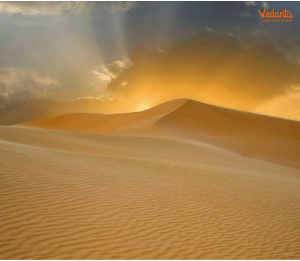
A Desert
Deserts are considered the driest places on Earth. They may go without rain for months or years. A desert can get fewer than 25 centimetres of rain in a year. The temperatures in a desert are extreme as well. It may become very hot during the day but extremely cold at night. The Sahara desert in Africa is considered to be the largest desert in the world. There are two types of deserts; hot deserts and cold deserts. The Sahara is the largest hot desert, whereas the Antarctica desert is the largest cold desert.
Places: Africa, Asia, North America, and Australia house some of the famous deserts of the world.
Plants and animals: Cacti, dates, and palm trees are some commonly found desert plants. The well-known desert animals include kangaroo rats, camels, desert foxes, rattlesnakes, iguanas, geckos, etc.
4. Mountain Habitat
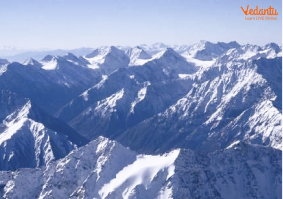
Mountainous Area
Mountains have varied vegetation as we move from the foothills to the top. With an increase in altitude, the temperature falls and the amount of plant growth decreases. It is very cold and windy at higher altitudes. Towards the foot of the mountain, one can find deciduous trees that shed their leaves during winter. Higher above, tall coniferous and evergreen trees are large in number. Ever farther up, alpine meadows, lichens, and mosses can be found. Thereafter, the snow-covered mountains and cold weather make it impossible for plants to thrive.
Places: Every continent on Earth has mountains. So, let us know about some interesting mountain facts. The longest mountain range, the Mid-Ocean Ridge, is under the ocean. The longest mountain range above the ground is the Andes. Mount Everest in Asia is the highest mountain above sea level.
Plants and animals: As mentioned earlier, the foothills of a mountain range have deciduous trees. Higher above, coniferous and evergreen trees cover the land. Lichens, alpine meadows, and mosses are found in extremely cold regions. Some popular mountain animals include red pandas, grizzly bears, angora rabbits, snow leopards, snow lions, mountain goats, yak, golden eagle, mountain goats, ibex, etc.
5. Aquatic Habitat
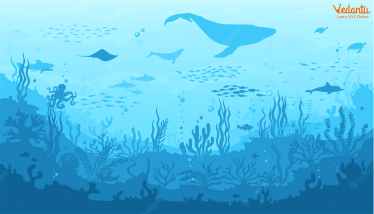
Fish and Plants under the Ocean
Aquatic habitats consist of environments where water is the primary source of survival. Plants may thrive on the surface of the water or under it. Some animals live in both water and land and some survive completely underwater. There are three types of aquatic habitats and these include freshwater, marine or saltwater, and coastal. Freshwater habitats consist of rivers, lakes, streams, ponds, etc. Saltwater habitats include oceans and seas. Coastal habitats are formed where the land meets the sea.
Places: The Earth is covered more in water than land. The Pacific Ocean is the largest ocean on Earth. The Nile in Africa is the longest river. The Caspian Sea is the largest inland water body. The Mariana Trench in the Pacific Ocean is the deepest part of the world.
Plants and animals: Water hyacinth, algae, water lilies, and willow trees are common freshwater plants. Alligators, fish, frogs, otters, turtles, etc. are commonly found in freshwater habitats. Popular marine plants comprise kelp, seaweed, seagrass, red algae, phytoplankton, corals, and algae. Whales, sharks, sea lions, jellyfish, shrimps, marine fish, dolphins, crabs, oysters, etc. are a few examples of the vast ocean life.
Conclusion
We hope you have enjoyed learning about the different types of habitats for kids. Each one has its unique characteristics which sustain the plants and animals living in it. If you destroy their habitat or remove them from their natural home, the plant or animal won’t live long. Hence, it is our responsibility to protect them and save their habitats.
FAQs on Habitats for Kids: Learn About Different Animal Homes
1. What is a habitat and what are its essential components?
A habitat is the natural home or environment of a plant, animal, or other organism. It provides everything an organism needs to survive. The most essential components of any habitat are:
- Food: To provide energy.
- Water: For drinking and other life processes.
- Shelter: To protect from predators and harsh weather.
- Space: Enough area to grow, find food, and raise young.
2. What are the main types of habitats on Earth with examples?
Habitats are broadly divided into two main types: terrestrial (land) and aquatic (water). Key examples include:
- Forests: Home to animals like monkeys, tigers, and birds.
- Deserts: Dry areas where camels and cacti live.
- Grasslands: Open plains where you can find lions and zebras.
- Polar Regions: Icy habitats for polar bears and penguins.
- Oceans and Seas: Saltwater homes for fish, whales, and corals.
- Rivers and Lakes: Freshwater habitats for frogs, ducks, and freshwater fish.
3. Why can't a polar bear survive in a desert?
A polar bear cannot survive in a desert because it is specially adapted for a cold, icy habitat. Its thick fur and a thick layer of body fat are designed to keep it warm, which would cause it to overheat dangerously in a hot desert. Furthermore, its main source of food, like seals, is not available in a desert environment.
4. How do animals adapt to live in extreme habitats like deserts or the Arctic?
Animals develop special features, called adaptations, to survive in their habitats. For example, a camel in the desert can store fat in its hump for energy and has long eyelashes to keep sand out of its eyes. In the Arctic, a polar bear has a thick coat of fur and blubber to stay warm, along with large paws to walk on snow and ice. These features help them thrive where other animals could not.
5. What are some examples of man-made habitats?
Man-made, or artificial, habitats are environments created by humans that can also become homes for various plants and animals. Some common examples include a city park, which provides a home for squirrels and birds; a farm with fields and barns for cows and chickens; and even a small garden pond, which can become a habitat for frogs and dragonflies.
6. What is the difference between a habitat and an ecosystem?
A habitat is like an organism's specific "address"—it is the physical place where it lives, such as a tree or a pond. An ecosystem is like the entire "neighbourhood"—it includes the habitat, all the living things (plants, animals), and the non-living things (like sunlight, water, and soil) interacting with each other in that area.
7. Can you give some examples of animals and the specific habitats they live in?
Certainly! Every animal is suited to its own special home. For example, a lion lives in the grasslands of Africa, a fish breathes in the water of oceans or rivers, a monkey swings through the trees in a rainforest, and a camel is perfectly adapted to live in the hot desert.















